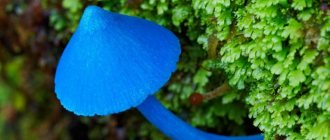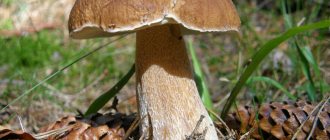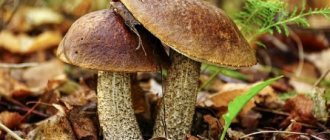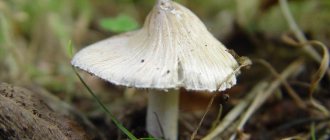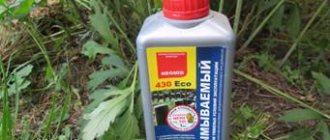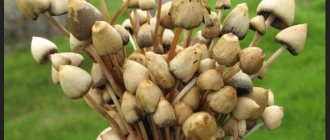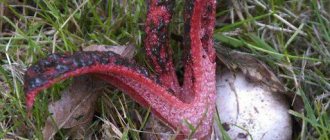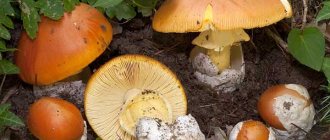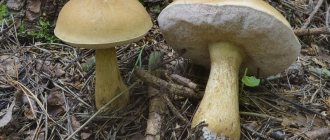There are quite a few lovers of “silent hunting” among residents of villages and towns surrounded by forests. Many of them eventually become real professionals in this matter, predicting the location of the prey, no matter how it hides. However, few people have heard about the “rabbit ears” mushroom: people tend to remember the appearance of what they are looking for and ignore what is uninteresting and unnecessary. Perhaps someone noticed the unusual creature, but only briefly noted the strange shape and passed by indifferently.
Sheep ears: planting
Chistets are planted in open ground as seedlings at the end of May.
Choose a sunny or slightly shaded place to plant the plant. The composition of the soil is not important, but the less nitrogen it contains, the better. Type - alkaline or neutral. The main condition is that the soil is light and well-drained. Young seedlings
Planting stages:
- Dig holes as deep as the plant's roots.
- Pave the bottom with a layer of pebbles or stones to create a drainage effect. Add coarse sand.
- Sprinkle a layer of a mixture of regular garden soil with fertilizer and humus on top.
- Carefully move the seedlings along with a lump of soil into the hole.
How to plant?
How to find water on the site: all methods and methods of searching.
Preparation of woolly aster seeds for planting begins at the end of February. Planting is done directly into open ground at average temperatures above 0 degrees and the soil does not freeze to a depth of 10 cm. After a month, the crops germinate. In the form of seedlings, plants are not transferred to open ground when grown at home too early. For the middle zone, planting dates fall in mid-April or early May. In the south, sowing seeds is often carried out in the autumn months at temperatures not lower than +10 degrees.
Preparing the soil for sheep's ears is not difficult. The plant retains its color and leaf edge only on not very fertile soils. For the same reason, it is not recommended to be overzealous with fertilizing the soil, otherwise the unusual edge of the leaves will be replaced by the usual green color with a barely noticeable fluff on the surface.
When choosing a place for planting on a site, you should give preference to light, breathable soils. The optimal choice would be rocky or loamy soil with neutral acidity. If its level is too high, it is recommended to add charcoal or lime to the soil. The selected location must be thoroughly loosened to a depth of 2 shovels. After this, young plants or a transplanted adult bush are placed in the prepared soil.
When choosing a location, it is recommended to give preference to well-lit or slightly shaded areas. It is in the sun that the woolly chickweed acquires its special decorative effect. You also need to take care of protecting it from drafts and drainage if the groundwater is high.
Care
How and when to collect Veselka mushroom
Hare's ears are an indoor flower that is unpretentious. You can fertilize it from time to time with complex fertilizer for indoor flowers. But the plant will develop quite well without performing this procedure. Organic fertilizers are contraindicated for hemanthus.
Water the hare's ear flower sparingly. If water stagnates, the bulb may dry out. However, it is not advisable to allow the soil in the pot to dry out.
Trim the hare's ear flower, the care of which is extremely simple, removing dried leaves as necessary. The peduncle must also be removed after the ovary has formed. Over time, it will die off on its own, but is capable of spoiling the appearance of the hemanthus for a long time. This plant also does not require spraying. The usual 60% humidity for city apartments is quite enough for him. The only thing is that you definitely need to provide the plant with plenty of diffused sunlight. It is best to place the flower on the window on the west side of the apartment. On warm days, it is advisable to take the plant out onto the balcony or into the garden. In this case, it must be placed in partial shade. Hemanthus should not be left in the sun. Otherwise, burns will appear on its leaves.
For the winter, the hare's ear flower, a photo of which you can see on the page, should be placed in a room with an air temperature of about 15 degrees. However, this plant tolerates a dormant period well even if it is simply shaded. Watering in cold weather is reduced. The lump should remain almost dry.
Variegated hedgehog
Photo gribnikoff.ru.
Acquaintance with this mysterious mushroom occurred relatively recently, in 2004, in the Gomel region. My friend and I went to pick mushrooms, right next to the Ukrainian border, where he has a dacha. And there I “picked up” several pieces of an unknown mushroom. A lot of time passed before it was possible to identify it: a mushroom-hedgehog, or correctly - variegated hedgehog, variegated sarcadon, hawk. Regional Belarusian names: ox tongue (Belostochina), elk (Vileyshchina, Gomel region), elk mushroom (Myadelshchina), bear (Lidchina), goat, sarny (Brest region), grouse (Svetlogorsk—Parichi—Ozarichi)…
I tried it later - I was a little afraid of such exoticism. Why am I writing about him now? Because they come out late, from the second half of August until November.
It is not very famous, even rare, but if you come across it, you can immediately cut up a whole heap. It has a specific aroma with bitterness. But after 5 minutes of cooking, the bitterness goes away, and then the blackberry can be boiled, fried, salted, pickled, or dried. You should know that it is better to eat young mushrooms. And the overripe ones, they say, are too bitter and tough.
Hedgehogs grow mainly in sandy pine forests, under pine trees, where there are a lot of needles.
Yellow hedgehog is also mentioned in the literature, but I have not yet had culinary contacts with it.
In a word, if the summer was wasted, then in October you can still run into “hedgehogs” and satisfy your mushroom itch.
How does culture reproduce?
Everything you wanted to know about cayenne pepper and its benefits
At home, the Stachys chist is propagated by seeds and the vegetative method.
Growing from seeds
Seed material can be purchased or prepared independently. Before planting, it is immersed in water to separate healthy seeds from empty and rotten ones. Selected specimens are etched for 2 hours in a light manganese solution.
Containers for disembarkation are selected either wooden or plastic. It is disinfected with boiling water, filled with soil, pouring drainage (expanded clay, pebbles) onto the bottom. The soil is suitable universally for seedlings. You can prepare it from turf soil, humus and sand - the plant is not picky about the soil.
The seeds need to be sown to a depth of 1-2 cm. Then the ground is sprayed, covered with film to create a greenhouse effect, and the containers are placed in a warm place. If you sow them by the end of February, then shoots will appear in March (in the third week).
Next you need to care for the seedlings. The film is opened slightly and the planting is ventilated. When 2-3 true leaves appear, the seedlings are picked and transplanted into separate containers. Hardening begins gradually. The first leaves of chistets seedlings are not fluffy, don’t be afraid of this.
In May, the plants are transferred to open ground, provided that there can no longer be return frosts in the area. The earthen lump with tender roots cannot be disturbed.
Important! After planting in open ground, the plantings are shaded from direct sunlight.
Dividing a bush is one of the ways of crop reproduction
Vegetative methods
Each part of the plant can be used for propagation:
- Cuttings. In summer, a fragment with 3-4 leaves is taken from a healthy stem. Root in water or nutrient substrate. When strong roots appear, they are transferred to a permanent place.
- Dividing the bush. Perennial varieties require updating. To do this, immediately after frost, the rhizome is dug up, divided into parts with a knife, and planted in the planned areas. The distance between plantings is left 20 cm. It is better to plant more densely so that there are no bald spots in the flowerbed.
- Planting tubers. In early spring or autumn, the plant is dug up and divided into tubers. If they need to be transplanted immediately, they are soaked in Kornevin and then just planted.
Important! Autumn tubers can be dried and stored until next season. All methods work, the gardener only needs to choose the appropriate one
Tubers are also bought in retail chains. So the pure Finch and the stachis Ambigua are sold in sets of 30 tubers
All methods work; the gardener only needs to choose the appropriate one. Tubers are also bought in retail chains. Thus, the pure Finch and the stachis Ambigua are sold in sets of 30 tubers.
Ringed cap
Photo sadovodu.com.
It is timely now to raise our voices in defense of one of the most widespread autumn mushrooms, which are so shamelessly trampled and crumbled underfoot by ignorant mushroom pickers, who would only give young boletus mushrooms... We will talk about the ringed cap (Rozites caperatus). Belarusians affectionately call this pinkish-red mushroom chicken. And also in different regions - swamps, mistakenly - champignons.
To be honest, I was somehow reluctant to collect them earlier, since I can find other good things - if only I had time. Yes, a couple of years ago Elena Laptyonok boasted that she had collected chickens, saying they were so tasty. In short, I was intrigued.
Let me remind you that they grow everywhere from the end of July to October in large families.
Pay attention and don't trample them. Chickens deserve a better life!
Guess what, guys: his hat is furry. A mushroom like a pink ear. What's his name? — Volnushka
How I love walking in the forest! For mushrooms, for berries - it doesn’t matter. The feeling itself is important, the mood
It is such a pleasure to smell the forest, see and hear its inhabitants. Well, if you’re lucky enough to pick a basket of mushrooms or berries, it’s actually a holiday!
Ivan-tea at the edge of the forest
I really love mixed forests with beautiful birch trees. The mushroom, the elegant beauty, also loves these forests.
In thin dresses at the edge of the forest, girlfriends lead a round dance. Dresses – striped silk: red, white, pink, satin. On an autumn day at the edge of the forest, How beautiful you are, little wave. I am always happy when I find a wave in the forest. She is so bright and elegant! And cleaning it is a pleasure.
Volnushka - from the genus of laticifers, secretes white, very caustic juice. Therefore, these mushrooms can be consumed only after soaking for 2-3 days, changing the water several times.
Autumn soon. Cobwebs fly by...
They don’t like us under the old birch tree - Two waves were agitated at the edge of the forest. But once in my basket, they calmed down... A little. S. Ostrovsky.
The pink wave has a sister - the white one. And if the pink wave is a beauty, always clean, even very rarely wormy, then the white one is a slob, even in dry weather it manages to stick all sorts of garbage on its curls.
Belyanka Mesopotamia, mushroom places
Among the people, the volnushka was usually called Volzhanka, Krasulya, volnukha or otvarnukha.
My first acquaintance with the wave was unsuccessful. I collected a basket of small pink, strong curls, washed it, fried it and... I had to throw it all away, the bitterness was incredible. I was perplexed - why is the pink wave so praised? I began to look it up in reference books and look for cooking recipes.
It turned out that volushka is a really tasty mushroom, mainly when pickled; I like it better when pickled cold; when picked hot, the mushrooms become softer. Volnushka is fried, boiled, pickled, but only after soaking for two to three days.
Forest anthill Having walked around the forest to your heart's content, recharged yourself with forest energy, inhaled to your heart's content the resinous smell of pine and spruce trees, you feel rested, not rejuvenated, but renewed, or something.
Double-decker fly agaric
My trophy
I sorted out the mushrooms, washed them, soaked them in cold water in a bucket, pressing them down with a plate so that they did not float up. Morning and evening for three days I washed and changed the water. On the fourth day, I took the mushrooms out of the water and let them drain well. In a saucepan mixed mushrooms, salt, garlic, cut into slices. Having mixed all this, I put it in jars, pressing it slightly, and covered it with a sheet of horseradish on top. My mushrooms stood at room temperature for a day, and the next I put them in the refrigerator.
We will try them only at the end of September. Volushki should be salted for 30-40 days.
In a clearing, near a river, Someone scattered rings, Pink, with fringe - What kind of mushroom is so wonderful?
This mushroom is called volushka. One wave, two waves, One, two, three, four... six We can’t count them all! Chuprova N. Do you like pink waves?
Usage
In nature, the chestnut mushroom often serves as a favorite delicacy for numerous forest inhabitants, primarily hares. That is why the popular name for chestnut mushroom is hare mushroom.
This rare gift of nature has also been used in cooking due to its nutritional value and a whole range of beneficial properties. Cooks use it mainly in dried form, since it gives off bitterness when cooked. This mushroom can also be fried, but it is not suitable for pickling or pickling.
However, lovers of quiet hunting should know that the chestnut tree is protected in Russia and its collection can be equated to poaching.
The chestnut mushroom is used in pharmaceuticals; the antibiotic boletol is obtained from its pulp.
The fruiting time is not long, as a rule, from the first weeks of the last summer month to the second half of September. Due to its rarity, the chestnut mushroom is not very popular among Russian mushroom pickers, but it can be picked by mistake, mistaking it for a boletus mushroom.
Chestnut mushrooms are rarely seen in Russian forests, and even if you find a mycelium, you should not destroy it, as this will be a direct violation of the law. However, you can grow it yourself; to do this, the mycelium is evenly scattered under deciduous trees onto previously loosened soil and sprinkled with humus mixed with forest soil on top.
Recipe for “Hot Bear Ears”:
In this recipe we will use Jasmine rice, vegetables, sunflower oil, flour. These products can be found in every housewife's home. The dish is hearty, tasty and LENTEN.
Cut the pepper into strips, grate the carrots, cut the onion into half rings
Fry vegetables in vegetable oil with the addition of tomato paste.
Fry until half cooked. Salt to taste
While the vegetables are cooking, take the rice and wash it
Add 1.5 cups of water, cook the rice until half cooked, add salt to taste.
Place the rice in a sieve and reserve the water. I got one glass of water. Let it stand and cool for a while, then drain the top half of the glass, and leave the other half of the glass with water.
And with this water we knead the dough (like dumplings)
Roll out the dough into a circle
Then fold the circle in half, roll the dough a little with a rolling pin
Now we fold the semicircle in half again, we get a quarter. And again we roll it into a circle. Do this 2-3 times so that the dough is much softer.
Recipes: Hare's ear
Inflammatory diseases of the respiratory system: 1 tablespoon of dried flowers in 2 cups of boiling water, leave for 2 hours, strain. Application: 1/2 cup warm 3-4 times a day with honey or sugar as tea.
Expectorant and enveloping agent: pour 1 tablespoon of dried flowers with 1 glass of boiling water, leave for 30 minutes, strain. Application: 1-2 tablespoons every 2-3 hours.
Diseases of the upper respiratory tract, shortness of breath, diarrhea, colitis and enterocolitis: 1 tbsp. l. Boil flowers and leaves of mullein in 200 ml of water for 5 minutes, leave for 1 hour, filter. Application: 2 tbsp. l. 3-4 times a day.
Article on the topic: Willow - useful properties, description
inflammatory diseases of the respiratory system: 3-4 teaspoons of dried flowers per 2 glasses of hot milk or hot water, boil over low heat, in a sealed container, leave for 30 minutes, strain, add honey or sugar to taste. Application: 1 glass at night, warm.
poultices: boil 3-4 tablespoons of flowers or leaves with boiling water, wrap in gauze and apply to sore spots.
gout, rheumatism, neuralgia: pour 50 g of flowers into 0.5 liters of 40% alcohol, leave for 10-12 days, strain. Application: use for rubbing into sore areas.
Popular types
There are more than 370 species in the genus Chistets, but only a few, the most decorative of them, have gained the greatest popularity.
Chistets woolly or Stachys woolly.
This decorative variety is very popular due to the very thick and long hair on the leaves. The length of the shoots is 20-40 cm. An unpretentious and frost-resistant plant blooms in summer with pink-purple flowers that last for 40-50 days.
Chistets woolly or Stachys woolly
Decorative varieties:
- Big Ears – low shoots are covered with shaggy leaves up to 25 cm long;
- Silver Carpet - a compact variety up to 15 cm high that forms a continuous silver-green carpet;
- Striped Phantom – white longitudinal stripes are visible on the surface of the leaves;
- Cotton Ball – the flowers of this variety resemble compact cotton bolls;
- Sheila Macqueen is a variety with low shoots and pubescent leaves; it does not produce flowers.
This species grows in wooded areas of Europe and Western Asia. Erect tetrahedral stems are covered with dark green shaggy leaves and end with bright crimson inflorescences. Used in medicine as a sedative and hemostatic agent.
A herbaceous perennial with highly branched, erect stems reaching a length of 60 cm. The plant is widespread in South Asia. It contains a large amount of vitamin C and essential oils.
An annual herb with pubescent leaves and large fragrant inflorescences. It is a good honey plant and is not used for medicinal purposes.
The plant, up to 50 cm high, has light green stems and lanceolate foliage, which are densely covered with short whitish hair. It blooms with large red-purple or purple inflorescences. It is used to treat hypertension and is also a fairly strong sedative.
The plant, up to 1.1 m high, has a dense stem and leaves with fine teeth on the sides. All terrestrial vegetation is covered with hard, downward-pointing villi. During the summer, lilac-purple flowers bloom above the grass. The plant is actively used in folk medicine to stop bleeding and heal wounds.
Caring for stachys, fertilizing and feeding
The woolly chist is an example of unpretentiousness on the site. Caring for it is simple:
- Watering - once a week in small doses. During a prolonged drought, the volume of water and the frequency of its application should be increased, otherwise the plant risks losing its leaves.
- At the beginning of flowering, stachys will need hilling. In addition, periodically loosen and weed the soil.
- Every spring, pick off dry old leaves. In summer, watch for growing root shoots. If they are not removed in time, they will spread and take over neighboring territories.
- Trim the inflorescences regularly. Due to ripe buds, the bush may fall apart.
Water your sheep's ears regularly, but little by little.
- To avoid bald spots in carpet planting, periodically replant young bushes in bare areas.
- Chistets is resistant to light frosts. However, during severe frosts it is better to cover the plant. Monitor winter weather closely. As soon as there is a thaw, remove the protective cover. Otherwise, the bush may burst.
- As the plant ages, a void will appear in the center of the leaf rosette. Once every 3-4 seasons, new soil should be poured into this place and a young seedling should be planted.
Advice. Cut buds can be used for bouquets as dried flowers in combination with other flowers.
Chistets are unpretentious not only in care, but also in feeding. Flower growers advise applying fertilizer 1-2 times a year, in the spring. Use chicken or cow manure in combination with ammonium nitrate. Sometimes organics are replaced with complex mineral mixtures. Fertilizer will help increase the plant's resistance to frost.
Storage period and conditions
The drug "Tetramizole" can be stored for 5 years from the date of release in a room protected from sunlight at a temperature not exceeding +30 °C. Also make sure that the storage area has moderate humidity and that the place where the medicine is stored is inaccessible to children and animals. Food should not be nearby either.
Helminthiasis, or more simply put, damage to the body by parasitic worms, called helminths or worms, occurs in humans, animals and even plants. Birds, including farm birds, are no exception. Infection of poultry with worms often leads to a number of negative consequences, and in particularly advanced cases, to the death of the bird. One of the effective means to combat this disease is tetramizole, instructions for use of which can be found below.
Literature
- Mushrooms: Directory / Transl. from Italian F. Dvin. - M.: “Astrel”, “AST”, 2001. - P. 218. - 304 p. — ISBN 5-17-009961-4
- Lesso T.
Mushrooms, key / trans. from English L.V. Garibova, S.N. Lekomtseva. - M.: “Astrel”, “AST”, 2003. - P. 194. - ISBN 5-17-020333-0 - Reference guide: Mushrooms / resp. for the release of Yu.G. Khatskevich. - Minsk: “Harvest”, 2002. - P. 138. - 7,000 copies. — ISBN 985-13-0913-3
- Mushrooms of the USSR. - M.: “Thought”, 1980.
- Dermek A.
Mushrooms. - Bratislava: Slovart, 1989. - P. 144-145.
Types and varieties of chistets
Woolly chick (Stachys lanata)
Not many species of chistets are grown in culture. Most often in flower beds you can find woolly chickweed, or woolly chickweed, or Byzantine chickweed, or sheep's ear chickweed (Stachys byzantiana). This plant comes from the Transcaucasus, the northwestern regions of Turkey and Iran, and the south of the European part of Russia. It is a rhizomatous perennial from 20 to 60 cm in height with tetrahedral, erect and sparsely leafy stems, thick spatulate or oblong-linear leaves, tapering towards the base and densely pubescent with white felt. The flowers of this species are small, lilac or pink-purple, collected in dense spike-shaped inflorescences. The species has been in cultivation since 1782. The most famous variety of the species is Silver Carpet - a plant only 15 cm high, forming a dense silver carpet.
Annual Chest (Stachys annua)
distributed in Europe, Asia Minor and Western Siberia. Its stems are from 15 to 35 cm high, simple or branched, usually bare below, short pubescent at the top. The lower leaves are crenate, oblong, wedge-shaped at the base, the upper leaves are sharp, serrate, lanceolate, sessile. The whitish-yellowish flowers are collected in long spike-shaped inflorescences. The fruit is a nut. Chistets annual is a honey plant.
Forest chist (Stachys sylvatica)
grows naturally in Turkey, the Caucasus, Europe, Central Asia, China and Russia. The plant reaches a height of 35 to 120 cm. Its stems are straight, ascending, and soft-haired. The stem leaves of the forest chickweed are petiolate, crenate-serrate, pointed towards the apex, ovate-heart-shaped, and the apical leaves are sessile, oblong, entire, light green on the upper side, gray-green below. The inflorescences are long, six to eight flowers.
Swamp chickweed (Stachys palustris)
or thorn, or blackberry, or columbine, or tenacious, distributed throughout Europe, in areas of Asia with a temperate climate from China to Iran, in Turkey, in Siberia and the European part of Russia. The plant reaches a height of 120 cm. It is densely covered with rough long hairs. The lower leaves are oblong, acute, rounded or heart-shaped at the base, finely toothed at the edges, and the upper ones are entire, ovate-lanceolate, sessile, long-pointed. Spike-shaped inflorescences consist of 6-10 purple-lilac flowers.
Grandiflora (Stachys grandiflora)
grows in the Caucasus and Asia Minor. It is a perennial with a height of 20 to 30 cm. Its leaves are long-petiolate, heart-shaped or round, crenate along the edge. Large flowers are collected in capitate inflorescences and are located on a leafless peduncle up to 50 cm high. This plant has several decorative forms, for example:
Spring garlic: planting and care in open ground
- alba - with white flowers;
- superba - with flowers ranging from pink to purple.
Chistets officinalis (Stachys officinalis)
is a Eurasian species with a wide habitat, height from 50 to 100 cm with crenate, oblong, heart-shaped, ovate leaves at the base. The basal leaves are long-petiolate, the upper leaves are almost sessile. The spike-shaped inflorescence consists of purple or dark pink hairy flowers.
In addition to the described species, fluffy, alpine, lavender-leaved, straight, narrow-leaved, field, German, Cretan and many others are also known.
Species and distribution
The woolly chist is found in the wild in mixed and coniferous forests, sometimes it grows in the steppe area. Ornamental varieties of garden Stachys Siebold are impressive with their variety of shapes and length of gray leaves, flower color and other botanical features:
- “Marvel” is a type of tall alphabetic plant reaching 50 cm;
- "Striped Phantom" - a variety with brightly colored leaves;
- “Sheep ears” - stem 30 cm long, lilac-pink dicotyledonous spikelets;
- “Silky Fleece” is a shrub 25 cm high. It has a pubescent light green crown and purple whorls of honey plants;
- “Big Ears” (Big Ears) - a variety with huge elongated leaves 25 cm;
- "Sheila Macqueen" is a squat shrub that does not form flower stalks;
- “Cotton Ball” – the cleanseed forms rounded spikelets of a silvery hue;
- "Primrose Heron" - pink flowers appear against the background of yellow leaves in spring;
- “Silver Carpet” is a low-growing plant up to 15 cm high, forms a continuous silver carpet. Used to decorate flower beds in the area adjacent to the house.
Where does Govorushka grow?
Funnel-headed talker grows in mixed forests in large numbers from the end of June to October, in all areas. Edible. Used fresh in soups. The decoction has a slightly “perfumy” aroma.
Only the caps of young mushrooms are eaten; the stems are hard and rubbery. Eat fresh after boiling for 20 minutes. Can be salted and dried.
Chistets Byzantine, marsh, large-flowered and others (with photo)
Chistets Byzantina (Stachys byzantina).
A herbaceous perennial, the height of which varies from 20 to 70 cm. It has straight, weakly branching shoots with silvery pubescence. The basal leaves are spatulate or elongated oval. The inflorescence is a dense spike consisting of many whorls with a large number of flowers.
The photo above shows that the Byzantine Chistets has tubular, pubescent flowers of a soft pink hue. The fruit is an oblong brown nut.
Annual guillemot (Stachys annua).
A herbaceous plant with simple or weakly branching shoots up to 35 cm high. The stems are slightly pubescent on top, their lower part is bare. The basal leaves are crenate, lanceolate, pointed at the base. The upper leaves are narrow, serrate along the edge, sessile. The inflorescence is a long spike with many yellow flowers.
Forest chickweed (Stachys sylvatica).
Bush height from 30 to 120 cm. Shoots are erect, covered with fine pile. The stem leaves are crenate, serrated along the edges, heart-shaped-ovate, pointed at the base. The apical leaves are oblong-oval, entire outermost, light green above, grayish on the underside. The inflorescence is a long panicle consisting of 6–8 flowers.
Swamp chickweed (Stachys palustris).
Bush 100 cm high and above. The stems and leaves are densely covered with long white hairs. The leaf blades located at the bottom of the stem are round or heart-shaped, pointed at the base, with small denticles along the edge. The upper leaves are elongated-oval, entire marginal, sessile. The inflorescence of the swamp grass, as shown in the photo below, is a spike consisting of 8 - 10 flowers of a lilac-purple hue.
Large-flowered chickweed (Stachys grandiflora).
Herbaceous perennial 20–30 cm high. Leaves are round or heart-shaped, entire outermost, crenate, attached to long petioles. The peduncle is bare, about 50 cm long. The inflorescence is capitate, consisting of large flowers.
Varieties of Stachys grandiflora:
"Alba" is a beautiful variety with snow-white inflorescences;
"Superba" is a beautiful variety of grandiflora with numerous flowers, the shade of which varies from bright red to soft pink.
There are other varieties of this species.
Officinalis (Stachys officinalis).
Bush height from 50 to 100 cm. Leaves are oblong, heart-shaped at the base, crenate. The upper leaf plates are sessile, the lower ones are attached to long petioles. The inflorescence is a spike with bright pink or purple flowers covered with hair.
Baikal chickweed (Stachys baicalensis).
A perennial herbaceous plant with creeping rhizomes. The stem is thin, erect, covered with fine hair, up to 60 cm high. The leaves are sessile, oblong-oval, oppositely located, serrated along the edge. The flowers are red in color, gradually turning purple.
Chistets hissarsky (Stáchys hissarica).
An herbaceous perennial with curved, branched, densely pubescent stems up to 40 cm high. The leaves are oval, heart-shaped at the base, up to 5 cm long, up to 4 cm wide. The lower leaf plates are oblong-ovate, the upper ones are of a similar shape, but smaller in size. The inflorescence consists of whorls with numerous red flowers.
It is worth considering photos of the species and varieties of chistets to understand which of them will fit most advantageously into the overall style of the site:
Popular types
There are more than 370 species in the genus Chistets, but only a few, the most decorative of them, have gained the greatest popularity.
Chistets woolly or Stachys woolly.
This decorative variety is very popular due to the very thick and long hair on the leaves. The length of the shoots is 20-40 cm. An unpretentious and frost-resistant plant blooms in summer with pink-purple flowers that last for 40-50 days.
Chistets woolly or Stachys woolly
Decorative varieties:
- Big Ears – low shoots are covered with shaggy leaves up to 25 cm long;
- Silver Carpet - a compact variety up to 15 cm high that forms a continuous silver-green carpet;
- Striped Phantom – white longitudinal stripes are visible on the surface of the leaves;
- Cotton Ball – the flowers of this variety resemble compact cotton bolls;
- Sheila Macqueen is a variety with low shoots and pubescent leaves; it does not produce flowers.
This species grows in wooded areas of Europe and Western Asia. Erect tetrahedral stems are covered with dark green shaggy leaves and end with bright crimson inflorescences. Used in medicine as a sedative and hemostatic agent.
A herbaceous perennial with highly branched, erect stems reaching a length of 60 cm. The plant is widespread in South Asia. It contains a large amount of vitamin C and essential oils.
An annual herb with pubescent leaves and large fragrant inflorescences. It is a good honey plant and is not used for medicinal purposes.
The plant, up to 50 cm high, has light green stems and lanceolate foliage, which are densely covered with short whitish hair. It blooms with large red-purple or purple inflorescences. It is used to treat hypertension and is also a fairly strong sedative.
The plant, up to 1.1 m high, has a dense stem and leaves with fine teeth on the sides. All terrestrial vegetation is covered with hard, downward-pointing villi. During the summer, lilac-purple flowers bloom above the grass. The plant is actively used in folk medicine to stop bleeding and heal wounds.
Application
Preparations made from chestnut mushrooms help with cerebral vascular spasms and epilepsy.
A water tincture is used to treat joints and psoriasis. If necessary, decoctions are used as an emetic and anthelmintic.
Chestnut mushroom has a weak aroma and a specific taste. To enhance the smell, it is subjected to heat treatment; it is more suitable for frying or boiling, as well as for drying, which reveals its qualities. It is not suitable for pickling due to its bitter taste. Hares love it, hence the second name of the mushroom - hare.
Diseases
Hare's ears are a fairly hardy flower and are rarely attacked by insects. Sometimes he is attacked by spider mites. In this case, the plant should be sprayed with wormwood infusion and watered with Aktara solution. Sometimes the plant's bulb rots. A similar problem can arise, as already mentioned, as a result of excessive watering and stagnation of water in the pot.
As you can see, bunny ears are an extremely unpretentious flower. All that is needed to achieve spectacular flowering is to water it from time to time and fertilize it occasionally. It can be a very good decoration for an apartment. Hemanthus is especially beautiful in summer, during flowering, which lasts about a month.
There are few people who can look with indifference at the delicate, velor-like texture of chistets leaves. In common parlance this plant is called “sheep’s ear.” This beautiful plant has lush leaves covered with light hairs. Its shoots grow up to 30 cm in height. Chest blooms for a long time. From the beginning of summer to the beginning of autumn, you can endlessly admire the delicate carpet created from this plant. It is ideal for decorating alpine slides, flower beds and flower greenhouses. The flowers of the chistets are tiny, collected in a spikelet, most often colored lilac.
"Sheep's ear"
Spruce weed - a mushroom in a glass cap
In coniferous forests, under spruce trees, a mushroom called spruce moth grows, quite common at first glance. But if you find young mushrooms, do not be alarmed by the slimy blanket that completely covers the cap and extends to the stem. From a distance it seems that the mushroom is wearing a glass cap or spacesuit. As it grows, the transparent blanket breaks, and its remains are visible only on the stem. In this form, the spruce moth also looks very beautiful: the cap is painted purple-brown. The pulp of the mushroom is light, smells pleasant and is very tasty.
general description
The leaves of hemanthus have a rich dark green hue. The plates themselves are quite wide and thick. They grow vertically upward in pairs, and their tips hang down on both sides, which gives them the appearance of bunny ears. Usually up to 4-6 leaves grow in one pot. In an adult hemanthus, their length can reach 30 cm. The height of the peduncle is 20-60 cm.
The hare's ear flower is a bulbous plant, and therefore does not like stagnant water. It needs good drainage in the pot. The bulb of this indoor flower is very large - up to 12 cm.
In winter, hemanthus begins a period of rest. This plant reproduces by seeds, daughter bulbs and leaves. Its main features also include the very slow growth of leaves. Also, apartment owners who want to purchase this plant should be aware that it can cause allergic reactions.
Interesting facts about the mushroom
Find out some interesting information about this forest “dweller”:
- Gyroporus chestnut was included in the Red Book in the 20th century.
- Chestnut mushroom is often confused with the Polish mushroom. Many are even sure that this is the same species. The Polish has a paler color and larger size.
- Many inexperienced mushroom pickers mistake gyroporus for a porcini mushroom, boletus mushroom. In order not to confuse them, you need to pay attention to the leg. Unlike the chestnut one, the boletus has a white or light brown barrel-shaped leg. In older specimens it may become cylindrical.
Do not forget that chestnut Giroporus is rare and is listed in the Red Book. Having found it in the forest, it is better to leave it in nature, choosing other, more common species.

